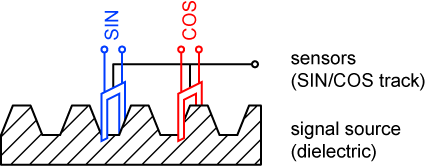Capacitive encoders
Capacitive encoders consist of a signal encoder and a sensor with an electrical field between them.
A toothed rotor is moved in the gap of the sensor, which changes the dielectric.
The sensor detects the changing field strength and converts this information into electrical signals.
If the rotor moves between the signal encoder and sensor, this generates a sine-shaped periodic signal in the sensor.
The number or periods through a rotor rotation is decisive for the accuracy of the actual position value.
The position of the rotor cannot be uniquely determined with a single sine signal. Two sensors, electrically offset by 90° are used that generate a sine and a cosine signal. Through evaluation of both signals, the rotor position and direction of rotation can be uniquely determined.
Inductive encoders are more robust against dust and oil contamination. The resolutions are lower than with optical encoders.
Basic construction of a capacitive encoder:

The following signal pattern results:

